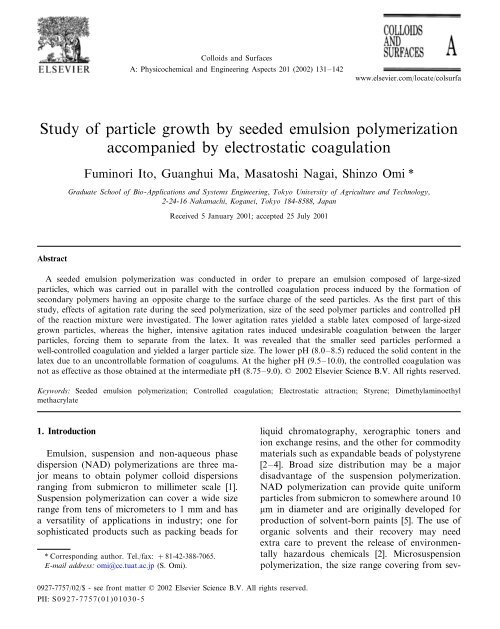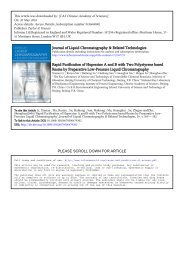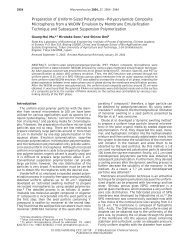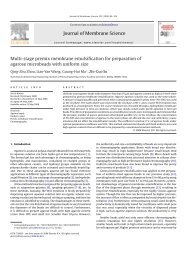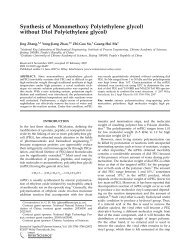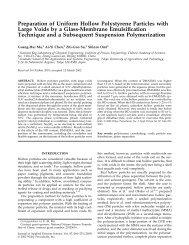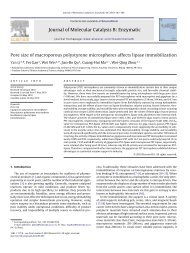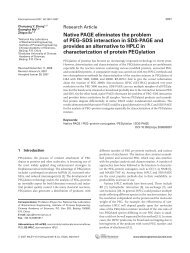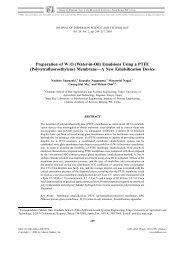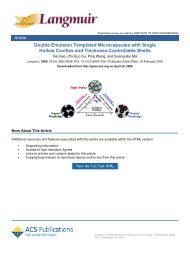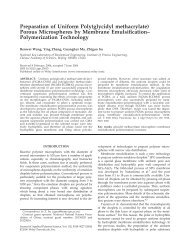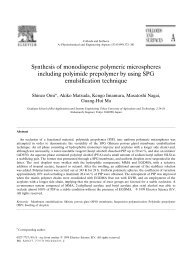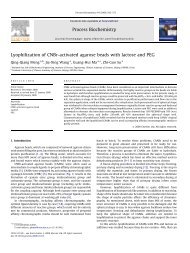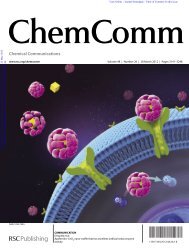Study of particle growth by seeded emulsion polymerization ...
Study of particle growth by seeded emulsion polymerization ...
Study of particle growth by seeded emulsion polymerization ...
Create successful ePaper yourself
Turn your PDF publications into a flip-book with our unique Google optimized e-Paper software.
Colloids and Surfaces<br />
A: Physicochemical and Engineering Aspects 201 (2002) 131–142<br />
www.elsevier.com/locate/colsurfa<br />
<strong>Study</strong> <strong>of</strong> <strong>particle</strong> <strong>growth</strong> <strong>by</strong> <strong>seeded</strong> <strong>emulsion</strong> <strong>polymerization</strong><br />
accompanied <strong>by</strong> electrostatic coagulation<br />
Fuminori Ito, Guanghui Ma, Masatoshi Nagai, Shinzo Omi *<br />
Graduate School <strong>of</strong> Bio-Applications and Systems Engineering, Tokyo Uniersity <strong>of</strong> Agriculture and Technology,<br />
2-24-16 Nakamachi, Koganei, Tokyo 184-8588, Japan<br />
Received 5 January 2001; accepted 25 July 2001<br />
Abstract<br />
A <strong>seeded</strong> <strong>emulsion</strong> <strong>polymerization</strong> was conducted in order to prepare an <strong>emulsion</strong> composed <strong>of</strong> large-sized<br />
<strong>particle</strong>s, which was carried out in parallel with the controlled coagulation process induced <strong>by</strong> the formation <strong>of</strong><br />
secondary polymers having an opposite charge to the surface charge <strong>of</strong> the seed <strong>particle</strong>s. As the first part <strong>of</strong> this<br />
study, effects <strong>of</strong> agitation rate during the seed <strong>polymerization</strong>, size <strong>of</strong> the seed polymer <strong>particle</strong>s and controlled pH<br />
<strong>of</strong> the reaction mixture were investigated. The lower agitation rates yielded a stable latex composed <strong>of</strong> large-sized<br />
grown <strong>particle</strong>s, whereas the higher, intensive agitation rates induced undesirable coagulation between the larger<br />
<strong>particle</strong>s, forcing them to separate from the latex. It was revealed that the smaller seed <strong>particle</strong>s performed a<br />
well-controlled coagulation and yielded a larger <strong>particle</strong> size. The lower pH (8.0–8.5) reduced the solid content in the<br />
latex due to an uncontrollable formation <strong>of</strong> coagulums. At the higher pH (9.5–10.0), the controlled coagulation was<br />
not as effective as those obtained at the intermediate pH (8.75–9.0). © 2002 Elsevier Science B.V. All rights reserved.<br />
Keywords: Seeded <strong>emulsion</strong> <strong>polymerization</strong>; Controlled coagulation; Electrostatic attraction; Styrene; Dimethylaminoethyl<br />
methacrylate<br />
1. Introduction<br />
Emulsion, suspension and non-aqueous phase<br />
dispersion (NAD) <strong>polymerization</strong>s are three major<br />
means to obtain polymer colloid dispersions<br />
ranging from submicron to millimeter scale [1].<br />
Suspension <strong>polymerization</strong> can cover a wide size<br />
range from tens <strong>of</strong> micrometers to 1 mm and has<br />
a versatility <strong>of</strong> applications in industry; one for<br />
sophisticated products such as packing beads for<br />
* Corresponding author. Tel./fax: +81-42-388-7065.<br />
E-mail address: omi@cc.tuat.ac.jp (S. Omi).<br />
liquid chromatography, xerographic toners and<br />
ion exchange resins, and the other for commodity<br />
materials such as expandable beads <strong>of</strong> polystyrene<br />
[2–4]. Broad size distribution may be a major<br />
disadvantage <strong>of</strong> the suspension <strong>polymerization</strong>.<br />
NAD <strong>polymerization</strong> can provide quite uniform<br />
<strong>particle</strong>s from submicron to somewhere around 10<br />
m in diameter and are originally developed for<br />
production <strong>of</strong> solvent-born paints [5]. The use <strong>of</strong><br />
organic solvents and their recovery may need<br />
extra care to prevent the release <strong>of</strong> environmentally<br />
hazardous chemicals [2]. Microsuspension<br />
<strong>polymerization</strong>, the size range covering from sev-<br />
0927-7757/02/$ - see front matter © 2002 Elsevier Science B.V. All rights reserved.<br />
PII: S0927-7757(01)01030-5
132<br />
F. Ito et al. / Colloids and Surfaces A: Physicochem. Eng. Aspects 201 (2002) 131–142<br />
eral submicrons to micrometers, has been developed<br />
for the commercial production <strong>of</strong> poly (vinyl<br />
chloride) (PVC) paste resin. A wide size distribution,<br />
even a bimodal distribution, is required for<br />
this purpose, and the microsuspension <strong>polymerization</strong><br />
has been rather limited to the PVC<br />
process.<br />
Conventional <strong>emulsion</strong> and mini-<strong>emulsion</strong><br />
<strong>polymerization</strong>s have been widely used for the<br />
commercial production <strong>of</strong> various lattices and<br />
extensively investigated from the academic point<br />
<strong>of</strong> view as well [1,6]. Their size ranges in most<br />
cases between several 10 nm and submicrons with<br />
an exception being the soap-free <strong>emulsion</strong> <strong>polymerization</strong><br />
from which nearly 1 m uniform<br />
spheres can be obtained, in particular, in the case<br />
<strong>of</strong> the hydrophobic monomers.<br />
From the survey <strong>of</strong> the size ranges <strong>of</strong> polymer<br />
<strong>particle</strong>s covered <strong>by</strong> each heterogeneous <strong>polymerization</strong><br />
system, one may note that there is no<br />
commercially feasible route to obtain fairly uniform<br />
<strong>particle</strong>s ranging from 0.5 to several microns.<br />
Agreeably, the <strong>seeded</strong> <strong>emulsion</strong><br />
<strong>polymerization</strong> technique, in principle, may cover<br />
this size range, however, it requires a skilled operation<br />
to be performed <strong>by</strong> several stages <strong>of</strong> <strong>polymerization</strong><br />
with carefully adjusted formulations <strong>of</strong><br />
soap, monomers, initiator and other ingredients.<br />
One could recall two ultimate <strong>seeded</strong> processes<br />
[7,8], one is a repeated <strong>seeded</strong> <strong>emulsion</strong> <strong>polymerization</strong>s<br />
carried out in the non-gravitational field<br />
<strong>by</strong> Vanderh<strong>of</strong>f et al. and the NASA group [7],<br />
and the other is the two-step swelling technique<br />
<strong>by</strong> Ugelstad et al. [8,9]. Both techniques successfully<br />
achieved extremely uniform polymeric microspheres<br />
up to 100 m.<br />
Going back to more realistic procedures, those<br />
<strong>particle</strong>s with the above size range (0.5 to several<br />
microns) are required in certain applications. For<br />
example, Dainippon Ink Co. (Dic) [10] commercialized<br />
a particular coating <strong>emulsion</strong> resistant to<br />
the shear thinning effect. An ionic monomer, 4-<br />
sulfonicstyrene, sodium salt (NaSS), was added in<br />
an ordinary formulation for coating <strong>emulsion</strong>. A<br />
controlled partial coagulation <strong>of</strong> growing polymer<br />
<strong>particle</strong>s took place in the early stage <strong>of</strong> soap-free<br />
<strong>emulsion</strong> <strong>polymerization</strong>, and the resultant <strong>particle</strong><br />
size distribution (PSD), including the agglomerates<br />
<strong>of</strong> several microns, successfully prevented<br />
the dripping <strong>of</strong> paints while brushing down vertically.<br />
The photograph showed grape-like agglomerates,<br />
two-dimensional rather than spherical<br />
shape. The present authors were inspired <strong>by</strong> this<br />
patent, and tried to establish an efficient route <strong>of</strong><br />
<strong>particle</strong> <strong>growth</strong> which could yield <strong>particle</strong>s <strong>of</strong> the<br />
above size range.<br />
The design scheme for <strong>particle</strong>s is illustrated in<br />
Fig. 1. By employing an anionic initiator, ammonium<br />
persulfate (APS), and an anionic surfactant,<br />
sodium lauryl sulfate (SLS), the seed polymer<br />
<strong>particle</strong>s <strong>of</strong> poly(methyl methacrylate-co-methyl<br />
acrylate) (PMMA-MA) were prepared (Fig. 1(a)).<br />
The seed polymer <strong>particle</strong>s were swollen with a<br />
comonomer composed <strong>of</strong> hydrophobic styrene<br />
and water-soluble, cationic dimethylaminoethyl<br />
methacrylate (DM). An adequate amount <strong>of</strong> nonionic<br />
surfactant, polyoxyethylene nonylphenyl<br />
ether (PEO23) was added to stabilize the seed<br />
<strong>particle</strong>s, and then the <strong>polymerization</strong> was carried<br />
out with a cationic initiator, 2,2-azobis(2-<br />
amidinopropane)·2HCl (V-50). Since DM is<br />
highly water-soluble, a fair amount <strong>of</strong> DM is<br />
partitioned in the aqueous phase which somewhat<br />
promotes the solubility <strong>of</strong> styrene as well (Fig.<br />
1(b)). The <strong>polymerization</strong> took place in the seed<br />
<strong>particle</strong>s swollen with monomers and also in the<br />
aqueous phase, leading to the nucleation and<br />
<strong>growth</strong> <strong>of</strong> the cationic secondary <strong>particle</strong>s <strong>of</strong><br />
poly(styrene-co-DM) (PS-DM). Meanwhile, the<br />
two-way coagulation and <strong>growth</strong> process progressed<br />
in parallel, the one induced <strong>by</strong> the coulombic<br />
attraction between the cationic secondary<br />
<strong>particle</strong>s and the anionic seeds, and the other <strong>by</strong><br />
the viscosity <strong>of</strong> the seed and coagulated <strong>particle</strong>s<br />
(Fig. 1(c)). The stability <strong>of</strong> the reaction system<br />
was readily maintained <strong>by</strong> the addition <strong>of</strong> PEO23<br />
as well as <strong>by</strong> the adjustment <strong>of</strong> pH, and fairly<br />
spherical, grown <strong>particle</strong>s were obtained having<br />
DM-rich domains on the surface and inside <strong>particle</strong>s<br />
(Fig. 1(d)) [11].<br />
By carefully designing the compositions <strong>of</strong> the<br />
seed polymer <strong>particle</strong>s and the secondary<br />
comonomer, a variety <strong>of</strong> morphologies can be<br />
created with this procedure. Encouraged with this<br />
result, in the present paper, the authors will report<br />
the effects <strong>of</strong> the agitation during the seed poly-
F. Ito et al. / Colloids and Surfaces A: Physicochem. Eng. Aspects 201 (2002) 131–142 133<br />
merization, the <strong>particle</strong> size <strong>of</strong> seeds, and the pH<br />
in the reaction medium to the outcome <strong>of</strong> <strong>growth</strong><br />
process. The detailed observation <strong>of</strong> the <strong>growth</strong><br />
mechanism will follow in the next paper.<br />
2. Experimental<br />
2.1. Materials<br />
Styrene (ST), methyl acrylate (MA) and methyl<br />
methacrylate (MMA) (Kishida Chemical Co.)<br />
were commercial grade, and distilled under reduced<br />
pressure. These reagents were stored in a<br />
refrigerator until use. Dimethyl aminoethyl<br />
methacrylate (DM, Tokyo Chemical Co.) was<br />
reagent grade and used as received. Ammonium<br />
persulfate (APS, Wako Pure Chemical Co.) and<br />
2,2-azobis (2-amidinopropane)·2HCl (V-50,Wako<br />
Pure Chemical Co.) were used as initiators to<br />
prepare seed latex P(MMA-co-MA) and to conduct<br />
the <strong>seeded</strong> <strong>emulsion</strong> <strong>polymerization</strong>,<br />
respectively.<br />
Sodium lauryl sulfate <strong>of</strong> biochemistry grade<br />
(SLS, Merck) was used as an emulsifier to prepare<br />
the seed latex P(MMA-co-MA). Polyoxyethylene<br />
nonylphenylether with 23 units <strong>of</strong> ethylene oxide<br />
(PEO23, Kao Co) was used to stabilize the swollen<br />
seed latex during the <strong>polymerization</strong>. t-Dodecyl<br />
mercaptan (TDM, Tokyo Chemical Co.) was<br />
used as a chain transfer agent to control molecular<br />
weight. Distilled and deionized (DDI) water<br />
was used.<br />
2.2. Polymerization apparatus<br />
A flat-bottomed glass separator flask with 500<br />
or 1000 ml capacity was used as a <strong>polymerization</strong><br />
reactor; the 500-ml flask was used for the <strong>seeded</strong><br />
<strong>emulsion</strong> <strong>polymerization</strong> and the 1000-ml flask<br />
was employed in seed latex preparation. A nitrogen<br />
inlet, a condenser, a thermocouple, and a<br />
dropping funnel for the initiator solution were<br />
connected to the top <strong>of</strong> the flask. A half-moon<br />
blade-type impeller was also used in this<br />
apparatus.<br />
Fig. 1. Schematic diagram <strong>of</strong> proposed seed <strong>polymerization</strong>.
134<br />
F. Ito et al. / Colloids and Surfaces A: Physicochem. Eng. Aspects 201 (2002) 131–142<br />
2.3. Preparation <strong>of</strong> PMMA-MA anionic seed<br />
latex<br />
One hundred and fifty grams each <strong>of</strong> MMA<br />
and MA dissolving 0.5 g <strong>of</strong> TDM was mixed with<br />
700 g <strong>of</strong> DDI water dissolving 2.0 g SLS with a<br />
magnet stirrer. The mixture was transferred to the<br />
reactor, and the nitrogen was bubbled through it<br />
for 1 h. After the temperature was raised to 333<br />
K, 30 ml <strong>of</strong> 0.2–0.8 g APS solution (also bubbled<br />
with the nitrogen stream) was added through the<br />
dropping funnel in a stream <strong>of</strong> nitrogen. The<br />
nitrogen atmosphere in the reactor was maintained<br />
throughout the <strong>polymerization</strong>. The <strong>polymerization</strong><br />
was conducted for 3.0 h.<br />
2.4. Analyses<br />
Monomer conversion was measured gravimetrically.<br />
A weighed latex sample was diluted with<br />
methanol and the precipitated polymer was separated<br />
<strong>by</strong> centrifugation. The polymer was washed<br />
with methanol <strong>by</strong> repeating the same procedure.<br />
The washed polymer was dried in a vacuum oven<br />
at room temperature and weighed. The resulting<br />
polymer <strong>particle</strong>s were observed <strong>by</strong> an SEM<br />
(JSM-5310.JEOL). The latex was diluted 10 000–<br />
20 000 times with DDI water, and one drop was<br />
placed on an aluminum film attached on the stub,<br />
and dried. Then gold was spattered on the surface<br />
with a film coater (JFC-1200 JEOL) before viewing.<br />
More than 200 <strong>particle</strong>s size were measured<br />
to calculate the average diameter <strong>of</strong> the <strong>particle</strong>s.<br />
The molecular weight <strong>of</strong> copolymers soluble in<br />
tetrahydr<strong>of</strong>uran (THF) was measured with a GPC<br />
(H810, Tosoh) which was calibrated using standard<br />
polystyrene samples. THF was used as an<br />
eluent solvent.<br />
The zeta-potentials <strong>of</strong> the polymer <strong>particle</strong>s<br />
were measured with a Zeecom apparatus (Microtech<br />
Nition). The latex was diluted 10 000 times<br />
with DDI water, and served for measurement.<br />
2.5. Seeded <strong>emulsion</strong> <strong>polymerization</strong><br />
The seed latex obtained was dialyzed with cellulose<br />
membrane (UC 27-32-100 Sankou Co.) for 24<br />
h under the continuous flow <strong>of</strong> tap water. Then<br />
they were soaked in 5 l DDI water overnight. The<br />
weight ratio <strong>of</strong> monomer and seed <strong>particle</strong>s (expressed<br />
as M/P hereafter) was adjusted to 2.0.<br />
The weight <strong>of</strong> total reaction mixture was 400 g.<br />
All the ingredients minus 25 ml <strong>of</strong> 0.25 g V-50<br />
solution were homogenized with an Ace Homogenizer<br />
(HF 93 SMT Co.) at 5000 rpm for 15 min,<br />
and transferred to the reactor. The <strong>particle</strong>s were<br />
allowed to absorb the comonomer for 1 h whilst<br />
the temperature was raised to 333 K. The initiator<br />
solution was then added in a similar way as in the<br />
preparation <strong>of</strong> seed latex. The <strong>polymerization</strong> was<br />
conducted for 20 h.<br />
3. Result and discussion<br />
3.1. Preparation <strong>of</strong> anionic seed latex<br />
The recipe for conventional <strong>emulsion</strong> <strong>polymerization</strong><br />
and the resulting characteristics <strong>of</strong> seed<br />
latex <strong>particle</strong>s are shown in Table 1. Run 1400<br />
was employed to investigate the effect <strong>of</strong> agitation<br />
rate during the <strong>seeded</strong> <strong>polymerization</strong> on the controlled<br />
coagulation and <strong>growth</strong> <strong>of</strong> <strong>particle</strong>s, Run<br />
1401, 1400, 1404, 1402 and 1403 were used for the<br />
different sized seeds, and Run 1407, for investigating<br />
the effect <strong>of</strong> pH. As 30 wt.% <strong>of</strong> monomer was<br />
present in the initial reaction mixture, it was<br />
difficult to control the reaction temperature at the<br />
<strong>particle</strong> nucleation stage due to the intensive heat<br />
<strong>of</strong> <strong>polymerization</strong> <strong>of</strong> MMA-MA, resulting in the<br />
poor reproducibility <strong>of</strong> the products (Run 1401,<br />
1400 and 1402) concerning the values such as the<br />
average diameter (number <strong>of</strong> polymer <strong>particle</strong>s),<br />
CV and -potential. All these properties are regarded<br />
to play the key roles in the controlled<br />
coagulation and <strong>growth</strong> process. In particular,<br />
nearly the same values <strong>of</strong> -potential were desired<br />
to investigate the effect <strong>of</strong> <strong>particle</strong> size, however,<br />
as shown later, a definite dependence on the seed<br />
<strong>particle</strong> size was obtained.<br />
3.2. Effect <strong>of</strong> agitation rate<br />
The effect <strong>of</strong> agitation rate (in other words,<br />
effect <strong>of</strong> shear rate) was investigated <strong>by</strong> employing<br />
the Run 1400 seed latex, the agitation rates
F. Ito et al. / Colloids and Surfaces A: Physicochem. Eng. Aspects 201 (2002) 131–142 135<br />
Table 1<br />
Characteristics <strong>of</strong> prepared seed latex for Runs 1400, 1401, 1402, 1403, 1404 and 1407<br />
Run Emulsifier (SLS) Initiator (APS) Conversion (%) Average CV (%) Number <strong>of</strong> seed <strong>particle</strong>s Mn (×10 −5 ) -Potential (mV)<br />
concentration (g)<br />
concentration (g)<br />
diameter (m) (×10 −14 dm −3 )<br />
1400 2.0 0.8<br />
98.6<br />
0.11<br />
11.1 4.24 2.16 −60.5<br />
1401 2.0 0.8 92.0 0.08<br />
22.4 10.7 2.14 −58.4<br />
1402 2.0 0.8 98.6<br />
0.16 6.96 1.40 2.12 −73.1<br />
1403 0.3 0.4<br />
82.6 0.25<br />
8.24 0.32 1.01 −47.5<br />
1404 2.0 0.2 98.8 0.14<br />
19.4 2.06 1.50 −69.0<br />
1407 8.0<br />
0.2 98.7<br />
0.10 12.5 5.66 1.51 −78.0
136<br />
F. Ito et al. / Colloids and Surfaces A: Physicochem. Eng. Aspects 201 (2002) 131–142<br />
Fig. 2. Agitation rate versus average <strong>particle</strong> size. Effect <strong>of</strong><br />
agitation rate at <strong>seeded</strong> <strong>emulsion</strong> <strong>polymerization</strong>.<br />
being selected as 180, 240, 350, 420 and 500 rpm.<br />
Table 2 shows the mutual recipe and some characteristics<br />
<strong>of</strong> the polymer <strong>particle</strong>s in the final latex.<br />
Fig. 2 shows the effect <strong>of</strong> agitation intensity on<br />
the average size <strong>of</strong> the resultant <strong>particle</strong>s and its<br />
distribution expressed as the coefficient <strong>of</strong> variation<br />
(CV, (standard deviation)/(average diame-<br />
ter)×100). SEM photographs <strong>of</strong> the final latex<br />
<strong>particle</strong>s are shown in Fig. 3.<br />
Interestingly, a sharp drop in the <strong>particle</strong> size<br />
and a broadening <strong>of</strong> its distribution (high CV)<br />
were observed beyond 350 rpm as a boundary.<br />
The normal trend <strong>of</strong> increasing the agitation rate<br />
during the <strong>polymerization</strong> revealed acceleration <strong>of</strong><br />
agglomeration between the <strong>particle</strong>s, leading to<br />
the larger size. In the present <strong>polymerization</strong> system,<br />
intensive agitation beyond 350 rpm may<br />
have enhanced the coagulation between the larger<br />
<strong>particle</strong>s which had already grown to a considerable<br />
size due to the other potential coagulative<br />
factor (coulombic attraction force). These successive<br />
coagulation processes deteriorated the stability<br />
<strong>of</strong> agglomerated <strong>particle</strong>s until they separated<br />
from the latex, creaming up to the surface, and<br />
forming a layer <strong>of</strong> coagulums there. Notice that<br />
the polymer <strong>particle</strong>s shown in Fig. 3(d,e) are the<br />
remnants <strong>of</strong> those which survived the further coagulation.<br />
Naturally, the sizes <strong>of</strong> surviving <strong>particle</strong>s<br />
are small. Fig. 4 shows substantial evidence<br />
that the solid content in the resultant latex (minus<br />
separated coagulum layer) decreased dramatically<br />
at the higher agitation rate.<br />
Fig. 3. SEM photographs <strong>of</strong> final latex <strong>particle</strong>s. Agitation rate (rpm) (a) 180; (b) 240; (c) 350; (d) 420; (e) 500.
F. Ito et al. / Colloids and Surfaces A: Physicochem. Eng. Aspects 201 (2002) 131–142 137<br />
Table 2<br />
Recipe and result <strong>of</strong> <strong>seeded</strong> <strong>emulsion</strong> co<strong>polymerization</strong>. (I) Effect <strong>of</strong> agitation rate<br />
Run Agitation rate Average <strong>particle</strong> size CV (%) -Potential Solid content in the final latex (g per g-lx) Average number <strong>of</strong><br />
(rpm) (m)<br />
(mV) coagulation<br />
408 180<br />
0.60<br />
15.4 −43.8<br />
0.234<br />
69.4<br />
404 240 0.57 15.2 −48.3<br />
0.202 68.9<br />
405 350 0.63<br />
18.2 −18.4 0.232<br />
81.0<br />
407 420 0.23 41.7 −22.1<br />
0.173<br />
–<br />
406 500<br />
0.29<br />
39.2 – 0.162 –<br />
Recipe: DDI water 189 g, seed latex (Run 1400) 131 g (solid content 40 g), PEO23 0.75 g, styrene 72 g, DM 8 g, TDM 0.24 g, initiator (V-50) 0.25 g; Initial pH <strong>of</strong><br />
the reaction mixture was 8.75; Polymerization was carried out at 333 K for 20 h.
138<br />
F. Ito et al. / Colloids and Surfaces A: Physicochem. Eng. Aspects 201 (2002) 131–142<br />
Fig. 4. Agitation rate versus final solid content in latex.<br />
On the other hand, the lower agitation rates<br />
(180, 240 and 350 rpm) provided a favorable<br />
shear field, maintained the controlled coagulation<br />
process and yielded a large <strong>particle</strong> size with a<br />
narrower size distribution (low CV). Also notice<br />
that the average <strong>particle</strong> size slightly increased<br />
until 350 rpm, implying a positive contribution <strong>of</strong><br />
the shear until this level without disrupting the<br />
controlled coagulation process. This tendency is<br />
more distinctively reflected in the average number<br />
<strong>of</strong> coagulation shown in Table 2, which is obtained<br />
from the following relationship provided<br />
that neither secondary nucleation took place, nor<br />
separated coagulums were present.<br />
N sp<br />
= w s d p 3<br />
(1)<br />
N p w p d sp<br />
N sp and N p denote the number <strong>of</strong> seed polymer<br />
<strong>particle</strong>s and the number <strong>of</strong> final <strong>particle</strong>s, respectively;<br />
w s and w p denote the solid content in the<br />
initial and final stage <strong>of</strong> latex, respectively; d sp and<br />
d p denote the average diameter <strong>of</strong> seed polymer<br />
<strong>particle</strong>s and that <strong>of</strong> the final coagulated <strong>particle</strong>s,<br />
respectively.<br />
The average number <strong>of</strong> coagulation for the<br />
grown <strong>particle</strong>s is estimated as 70–80, demonstrating<br />
that the present seed <strong>polymerization</strong> provides<br />
an effective <strong>growth</strong> process.<br />
Interestingly, -potential <strong>of</strong> the resultant latex<br />
remained negative, and its absolute value de-<br />
creased as the agitation rate was increased. One<br />
may speculate that the cationic ST-DM domains<br />
tend to be engulfed inside the grown <strong>particle</strong>s at<br />
the low shear process, whilst at the higher shear<br />
rate, those domains tend to be adsorbed on the<br />
surface (Fig. 1). In our first paper, we confirmed<br />
these two domains <strong>by</strong> the TEM observation <strong>of</strong><br />
microtomed cross-sectional area <strong>of</strong> the <strong>particle</strong>s<br />
stained with the vapor <strong>of</strong> methyl iodide [11,12].<br />
One <strong>of</strong> the disadvantages <strong>of</strong> this <strong>growth</strong> process is<br />
a moderate conversion <strong>of</strong> monomer in the <strong>seeded</strong><br />
<strong>polymerization</strong> as predicted from Fig. 4. The<br />
monomer conversion attained at most 67% (Runs<br />
408 and 405) because the water soluble radicals<br />
generated from V-50 may not be able to diffuse<br />
into the grown <strong>particle</strong>s in the later stage <strong>of</strong><br />
<strong>polymerization</strong>. Attempts to raise the conversion<br />
at the later stage are being investigated.<br />
3.3. Effect <strong>of</strong> seed <strong>particle</strong> size<br />
The effect <strong>of</strong> <strong>particle</strong> size in the seed latex on<br />
the controlled coagulation and <strong>growth</strong> process<br />
was investigated using the seed lattices with the<br />
average size changed from 0.08 to 0.25 m. The<br />
recipe and some characteristics <strong>of</strong> the polymer<br />
<strong>particle</strong>s in the final latex is shown in Table 3. The<br />
final average <strong>particle</strong> size is in the range <strong>of</strong> 0.55–<br />
0.76 m with the coefficient <strong>of</strong> variation 10–20%.<br />
Fig. 5 shows the plot <strong>of</strong> the <strong>particle</strong> <strong>growth</strong> ratio,<br />
Fig. 5. Growth ratio <strong>of</strong> <strong>particle</strong>s before and after <strong>seeded</strong><br />
<strong>emulsion</strong> <strong>polymerization</strong> against the seed <strong>particle</strong> size.
F. Ito et al. / Colloids and Surfaces A: Physicochem. Eng. Aspects 201 (2002) 131–142 139<br />
Table 3<br />
Recipe and result <strong>of</strong> the <strong>seeded</strong> <strong>emulsion</strong> co<strong>polymerization</strong>. (II) Effect <strong>of</strong> seed <strong>particle</strong> size<br />
Run Seed <strong>particle</strong> size Average <strong>particle</strong> size CV (%) -Potential Solid content in the final latex Average number <strong>of</strong><br />
(m) (m)<br />
(mV) (g per g-lx)<br />
coagulation<br />
409 0.08<br />
0.62<br />
12.4 −42.7<br />
0.260<br />
179.0<br />
408 a 0.11 0.60 15.4 −43.8<br />
0.234 69.4<br />
437 0.14 0.56<br />
16.7 −26.5 0.269<br />
23.8<br />
417 0.16 0.55 18.1 −27.6<br />
0.248<br />
16.4<br />
421 0.25<br />
0.76<br />
16.4 −21.0 0.192 14.6<br />
Each reaction mixture was made up so that the solid content was 40 g in 320 g <strong>of</strong> the seed latex diluted with DDI water. PEO23 1.50 g, styrene 72 g, DM 8 g, TDM<br />
0.24 g, initiator (V-50) 0.25 g; Initial pH <strong>of</strong> the reaction mixture was 8.75; Agitation rate was 180 rpm; Polymerization was carried out at 333 K for 20 h.<br />
a 0.75 g <strong>of</strong> PEO23 was used.
140<br />
F. Ito et al. / Colloids and Surfaces A: Physicochem. Eng. Aspects 201 (2002) 131–142<br />
Table 4<br />
Recipe and result <strong>of</strong> the <strong>seeded</strong> <strong>emulsion</strong> co<strong>polymerization</strong>. (III) Effect <strong>of</strong> pH control<br />
Run pH Average <strong>particle</strong> CV (%) -Potential Solid content in the final latex Average number <strong>of</strong><br />
size (m)<br />
(mV)<br />
(g per g-lx)<br />
coagulation<br />
451 8.0 0.24<br />
23.4 4.60 0.190 –<br />
452 8.5 0.31<br />
7.47 11.6 0.170 –<br />
408 a 8.75 0.60 15.4 −43.8<br />
0.234<br />
69.4<br />
450 9.0 0.45 22.2 −14.0 0.224 40.5<br />
449 9.5 0.29 13.5 −34.5 0.251 9.64<br />
448 10.0 0.28 9.55 −27.6<br />
0.236<br />
9.27<br />
Recipe: DDI water 182 g, seed latex (Run 1407) 138 g (solid content 40 g), PEO23 1.5 g, styrene 72 g, DM 8 g, TDM 0.24 g, initiator<br />
(V-50) 0.24 g; Agitation rate was 180 rpm; Polymerization was carried out at 333 K for 24 h.<br />
a Run 1400 was employed as a seed latex (see Table 3).<br />
d p /d sp , against the seed <strong>particle</strong> size. The average<br />
number <strong>of</strong> coagulated seed <strong>particle</strong>s can be estimated<br />
from Eq. (1) and is shown in Table 3 which<br />
may reveal more clearly that the efficient <strong>growth</strong><br />
<strong>of</strong> polymer <strong>particle</strong>s progressed under the controlled<br />
coagulation <strong>of</strong> smaller seed <strong>particle</strong>s (Runs<br />
409 and 408) compared to the larger seed <strong>particle</strong>s<br />
(Runs 437, 417 and 421). Run 421 yielded the<br />
highest average diameter <strong>of</strong> the resultant <strong>particle</strong>s<br />
(0.76 m), however, the lowest solid content implied<br />
poor stability with a low absolute value <strong>of</strong><br />
-potential, leading to the formation <strong>of</strong><br />
coagulums.<br />
On the other hand, the runs with smaller seed<br />
<strong>particle</strong>s (Runs 409 and 408) maintained reasonable<br />
values <strong>of</strong> -potential. Suppose that the resultant<br />
grown <strong>particle</strong> size is in same order as shown<br />
in Table 3. As the surface area, in other words,<br />
the surface charge <strong>of</strong> the larger number <strong>of</strong> small<br />
size <strong>particle</strong>s is higher than that <strong>of</strong> the smaller<br />
number <strong>of</strong> large size <strong>particle</strong>s, the former grown<br />
<strong>particle</strong> still possesses extra anionic charges after<br />
the controlled coagulation process with cationic<br />
polymers or <strong>particle</strong>s during the seed <strong>polymerization</strong><br />
period. This speculation may be justified <strong>by</strong><br />
the higher absolute value <strong>of</strong> -potentials in Runs<br />
409 and 408. As a conclusion, it can be said that<br />
the smaller sized seed <strong>particle</strong>s are preferred for<br />
conducting the <strong>growth</strong> process involving the controlled<br />
coagulation <strong>of</strong> seed <strong>particle</strong>s. This conclusion<br />
seems to emphasize an importance <strong>of</strong> the<br />
establishment <strong>of</strong> procedure and probably the<br />
choice <strong>of</strong> equipment as well in order to maintain<br />
the reproducible production <strong>of</strong> seed lattices. Even<br />
a small perturbation <strong>of</strong> the reaction temperature<br />
during the nucleation period is reflected in fluctuations<br />
in the average diameter <strong>of</strong> final <strong>particle</strong>s<br />
and the number <strong>of</strong> polymer <strong>particle</strong>s. Semi-batch<br />
(or semi-continuous) operation will be recommended<br />
to suppress extensive heat generation in<br />
the earlier stage <strong>of</strong> batch <strong>polymerization</strong>. A majority<br />
<strong>of</strong> monomers can be added continuously<br />
after the <strong>particle</strong> nucleation settled down.<br />
3.4. Effect <strong>of</strong> controlling the pH <strong>of</strong> the reaction<br />
mixture<br />
Up to this section, no attempt was made to<br />
adjust the pH <strong>of</strong> the reaction mixture before<br />
undertaking the <strong>seeded</strong> <strong>polymerization</strong>. The measured<br />
pH values were 8.75. The ionization degree<br />
<strong>of</strong> DM and V-50 (pK a -values <strong>of</strong> primary and<br />
tertiary amines are reported to be in the range,<br />
10–11) [13] will affect the -potential <strong>of</strong> seed<br />
<strong>particle</strong>s as well. Under these predictions, the pH<br />
<strong>of</strong> the reaction mixture was adjusted from 8.0 to<br />
10.0 <strong>by</strong> adding HCl or KOH after the swelling<br />
process <strong>of</strong> DM and styrene. Run 1407 was employed<br />
as a seed latex. The average diameter <strong>of</strong><br />
seed <strong>particle</strong>s was 0.10 m. The details <strong>of</strong> the<br />
recipe and the results <strong>of</strong> <strong>seeded</strong> <strong>polymerization</strong>s<br />
are shown in Table 4. Run 408, which was carried<br />
out using a slightly different size <strong>of</strong> the seed<br />
<strong>particle</strong>s (0.11 m), is included in the table for<br />
further discussion. There was a marked change in<br />
the results as the pH shifted from 8.5 to 9.0. At
F. Ito et al. / Colloids and Surfaces A: Physicochem. Eng. Aspects 201 (2002) 131–142 141<br />
the lower pH (8.0 and 8.5), the final solid content<br />
decreased due to the formation <strong>of</strong> coagulums just<br />
as we observed in the experiments employing a<br />
higher agitation rate. Also, the positive and low<br />
values <strong>of</strong> -potential implied that quite a few<br />
secondary <strong>particle</strong>s were nucleated because <strong>of</strong> the<br />
enhanced ionization <strong>of</strong> DM in the aqueous phase.<br />
An increase in charged DM will favor its partition<br />
in the aqueous phase, and stabilize the oligomeric<br />
chains nucleated in the aqueous phase, allowing<br />
them to grow independently as secondary <strong>particle</strong>s.<br />
Unless secondary <strong>particle</strong>s are suppressed, no<br />
stable <strong>growth</strong> process may be accomplished even<br />
though the amount <strong>of</strong> nonionic surfactant is<br />
increased.<br />
On the other hand, at the higher pH (9.5 and<br />
10.0), only a moderate coagulation proceeded, as<br />
the ionization <strong>of</strong> DM was suppressed, reducing<br />
the electrostatic attraction between the oppositely<br />
charged <strong>particle</strong>s. The secondary nucleation was<br />
less enhanced as indicated from the lower values<br />
<strong>of</strong> CV. (Note that the lowest CV for Run 452 was<br />
obtained from the remaining small-sized <strong>particle</strong>s<br />
after a majority <strong>of</strong> grown <strong>particle</strong>s uncontrollably<br />
coagulated.) Definitely, an optimal pH range<br />
(8.75–9.0) existed where a moderate ionization <strong>of</strong><br />
DM allowed a controllable coagulation process to<br />
progress, yielding effectively grown <strong>particle</strong>s with<br />
a reasonably narrow size distribution.<br />
3.5. Brief outline <strong>of</strong> coagulation mechanism<br />
A series <strong>of</strong> experiments are now in progress in<br />
which the <strong>growth</strong> <strong>of</strong> polymer <strong>particle</strong> is closely<br />
observed <strong>by</strong> SEM photographs <strong>of</strong> the lattices<br />
withdrawn at certain time intervals. Although the<br />
investigations are <strong>by</strong> no means complete, it is<br />
implied that substantial coagulation <strong>of</strong> seed <strong>particle</strong>s<br />
had already started during the swelling period<br />
<strong>of</strong> comonomer into the polymer <strong>particle</strong>s before<br />
the <strong>polymerization</strong>. Further <strong>growth</strong> <strong>of</strong> polymer<br />
<strong>particle</strong>s followed and continued until approximately<br />
50% monomer conversion, thereafter the<br />
<strong>growth</strong> levelled <strong>of</strong>f. No more aggressive coagulation<br />
took place. The amount <strong>of</strong> PEO23 affected<br />
the initial coagulation and further <strong>growth</strong> as well,<br />
excess addition <strong>of</strong> PEO23 induced the secondary<br />
nucleation and poor <strong>growth</strong>, whereas deficiency<br />
resulted in an excessive coagulation and poor<br />
monomer conversion. Investigation <strong>of</strong> other factors<br />
and detailed analyses will be submitted later.<br />
4. Conclusion<br />
Anion-charged seed <strong>particle</strong>s, poly (MMA-co-<br />
MA), were prepared using anionic SLS and initiator<br />
APS, and <strong>seeded</strong> <strong>emulsion</strong> co<strong>polymerization</strong><br />
was conducted with a comonomer DM and initiator<br />
V-50 having counter-ions (cationic) against<br />
the seed <strong>particle</strong>s, in order to obtain large-sized<br />
composite <strong>particle</strong>s. The effects <strong>of</strong> agitation rate,<br />
seed <strong>particle</strong> size and controlled pH in the reaction<br />
mixture were examined. Increasing the agitation<br />
rate, such as to 420 and 500 rpm, reduced the<br />
solid content in the lattices due to an uncontrollable<br />
coagulation between the grown <strong>particle</strong>s<br />
which resulted in the separation <strong>of</strong> coagulums.<br />
The remaining <strong>particle</strong> size was small and the size<br />
distribution became broader. Moderate agitation,<br />
up to 350 rpm, favored the controlled coagulation<br />
<strong>of</strong> the seed <strong>particle</strong>s in parallel with the <strong>growth</strong>,<br />
leading to the large-sized <strong>particle</strong>s with a reasonably<br />
narrow size distribution. Smaller size seed<br />
<strong>particle</strong>s promoted controlled <strong>particle</strong> <strong>growth</strong>,<br />
yielding a larger <strong>particle</strong> <strong>growth</strong> ratio, d p /d sp .Reproducibility<br />
<strong>of</strong> the anionic <strong>particle</strong> size is there<strong>by</strong><br />
essential. The lower pH (8.0–8.5) reduced the<br />
solid content in the latex because <strong>of</strong> the formation<br />
<strong>of</strong> large amounts <strong>of</strong> coagulums just as we observed<br />
at the high agitation rate. At the higher pH<br />
(9.5–10.0), the controlled coagulation was not so<br />
effective due to the suppression <strong>of</strong> cationic ions.<br />
Consequently, the intermediate pH (8.75–9.0),<br />
with an adequate balance between the counter<br />
ions, yielded the large-sized grown <strong>particle</strong>s with a<br />
narrow size distribution. In the next article, the<br />
detailed <strong>growth</strong> and controlled coagulation behavior<br />
<strong>of</strong> the seed <strong>particle</strong>s will be reported.<br />
References<br />
[1] G.-H. Ma, in: K. Esumi (Ed.), Polymer Interfaces and<br />
Emulsions, Marcel Dekker, New York, 1999 Chapter 3.<br />
[2] S. Gu, T. Mogi, M. Konno, J. Colloid. Interf. Sci. 207<br />
(1998) 113–118.
142<br />
F. Ito et al. / Colloids and Surfaces A: Physicochem. Eng. Aspects 201 (2002) 131–142<br />
[3] S. Omi, T. Taguchi, M. Nagai, G.-H. Ma, J. Appl.<br />
Polym. Sci. 63 (1997) 931–942.<br />
[4] S. Omi, K. Katami, A. Yamamoto, M. Iso, J. Appl.<br />
Polym. Sci. 51 (1994) 1–11.<br />
[5] K.E.J. Barrett (Ed.), Dispersion Polymerization in Organic<br />
Media, Wiley, New York, 1974.<br />
[6] P.A. Lovell, M.S. El-Aasser (Eds.), Emulsion Polymerization<br />
and Emulsion Polymers, Wiley, New York, 1997.<br />
[7] J.W. Vanderh<strong>of</strong>f, M.S. El-Aasser, F.J. Micale, E.D. Sudol,<br />
C.M. Tseng, H.R. Scheu, D.M. Cornfeld, ACS<br />
Polym. Preprint 28 (1986) 455–456.<br />
[8] J. Ugelstad, K.H. Kaggerud, F.K. Hansen, A. Berge,<br />
Makromol. Chem 180 (1979) 737–744.<br />
[9] J. Ugelstad, Makromol. Chem. 179 (1978) 815–817.<br />
[10] Y. Hasegawa, Technologies for Productions <strong>of</strong> Functional<br />
and Composite Polymeric Microspheres, Assessment<br />
<strong>of</strong> Polymer Manufacturing Process No. 17, The<br />
Society <strong>of</strong> Polymer Science, Japan, 1995, pp. 185–189 (in<br />
Japanese).<br />
[11] S. Omi, K. Fujiwara, M. Nagai, G.-H. Ma, A. Nakano,<br />
Colloid. Surfaces A Physicochem. Eng. Asp. 153 (1999)<br />
165–172.<br />
[12] K. Fujiwara, MS thesis, Tokyo University <strong>of</strong> Agriculture<br />
and Technology, 1998.<br />
[13] N.L. Allinger, M.P. Cava, D.C. Dejongh, C.R. Johnson,<br />
N.A. Lebel, C.L. Stevens, Organic Chemistry, Worth<br />
Publishers, 1971, p. 338 (Japanese edition).


